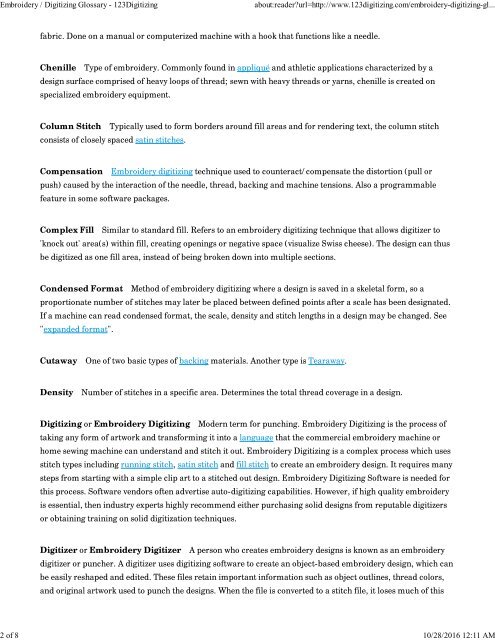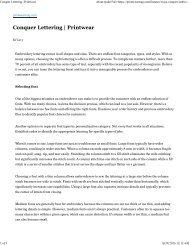Embroidery Basics Articles
Create successful ePaper yourself
Turn your PDF publications into a flip-book with our unique Google optimized e-Paper software.
<strong>Embroidery</strong> / Digitizing Glossary - 123Digitizing<br />
about:reader?url=http://www.123digitizing.com/embroidery-digitizing-gl...<br />
2 of 8 10/28/2016 12:11 AM<br />
fabric. Done on a manual or computerized machine with a hook that functions like a needle.<br />
Chenille Type of embroidery. Commonly found in appliqué and athletic applications characterized by a<br />
design surface comprised of heavy loops of thread; sewn with heavy threads or yarns, chenille is created on<br />
specialized embroidery equipment.<br />
Column Stitch Typically used to form borders around fill areas and for rendering text, the column stitch<br />
consists of closely spaced satin stitches.<br />
Compensation <strong>Embroidery</strong> digitizing technique used to counteract/compensate the distortion (pull or<br />
push) caused by the interaction of the needle, thread, backing and machine tensions. Also a programmable<br />
feature in some software packages.<br />
Complex Fill Similar to standard fill. Refers to an embroidery digitizing technique that allows digitizer to<br />
'knock out' area(s) within fill, creating openings or negative space (visualize Swiss cheese). The design can thus<br />
be digitized as one fill area, instead of being broken down into multiple sections.<br />
Condensed Format Method of embroidery digitizing where a design is saved in a skeletal form, so a<br />
proportionate number of stitches may later be placed between defined points after a scale has been designated.<br />
If a machine can read condensed format, the scale, density and stitch lengths in a design may be changed. See<br />
"expanded format".<br />
Cutaway One of two basic types of backing materials. Another type is Tearaway.<br />
Density Number of stitches in a specific area. Determines the total thread coverage in a design.<br />
Digitizing or <strong>Embroidery</strong> Digitizing Modern term for punching. <strong>Embroidery</strong> Digitizing is the process of<br />
taking any form of artwork and transforming it into a language that the commercial embroidery machine or<br />
home sewing machine can understand and stitch it out. <strong>Embroidery</strong> Digitizing is a complex process which uses<br />
stitch types including running stitch, satin stitch and fill stitch to create an embroidery design. It requires many<br />
steps from starting with a simple clip art to a stitched out design. <strong>Embroidery</strong> Digitizing Software is needed for<br />
this process. Software vendors often advertise auto-digitizing capabilities. However, if high quality embroidery<br />
is essential, then industry experts highly recommend either purchasing solid designs from reputable digitizers<br />
or obtaining training on solid digitization techniques.<br />
Digitizer or <strong>Embroidery</strong> Digitizer A person who creates embroidery designs is known as an embroidery<br />
digitizer or puncher. A digitizer uses digitizing software to create an object-based embroidery design, which can<br />
be easily reshaped and edited. These files retain important information such as object outlines, thread colors,<br />
and original artwork used to punch the designs. When the file is converted to a stitch file, it loses much of this




